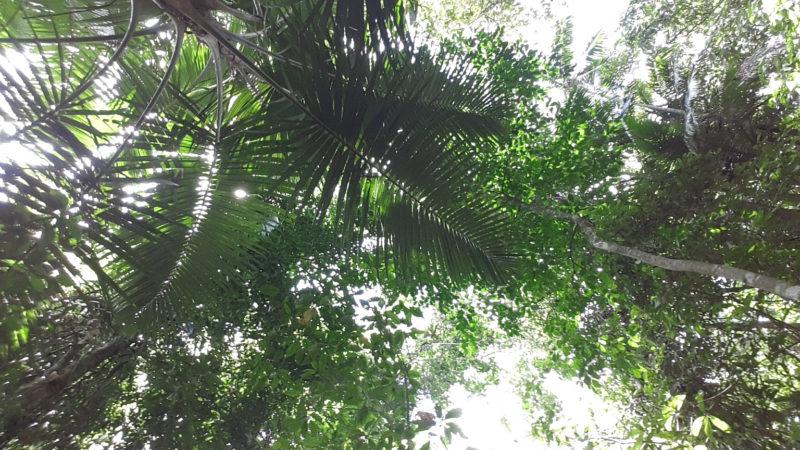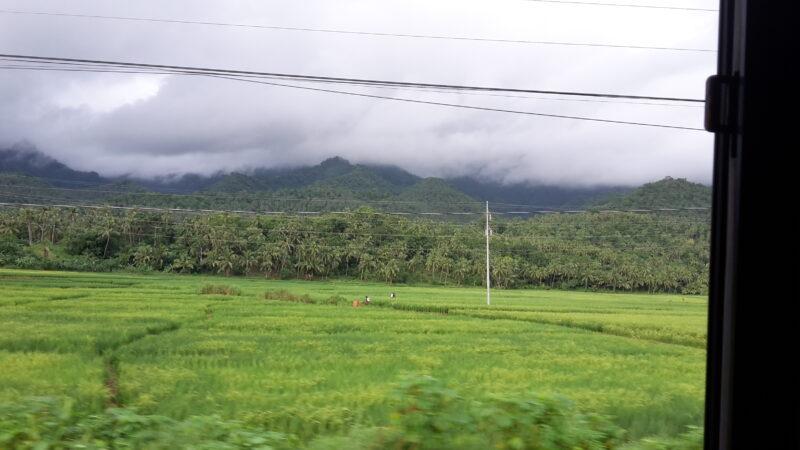
Landscape of Leyte – April 2022
Christopher Klapperich
Rethinking fieldwork through disaster
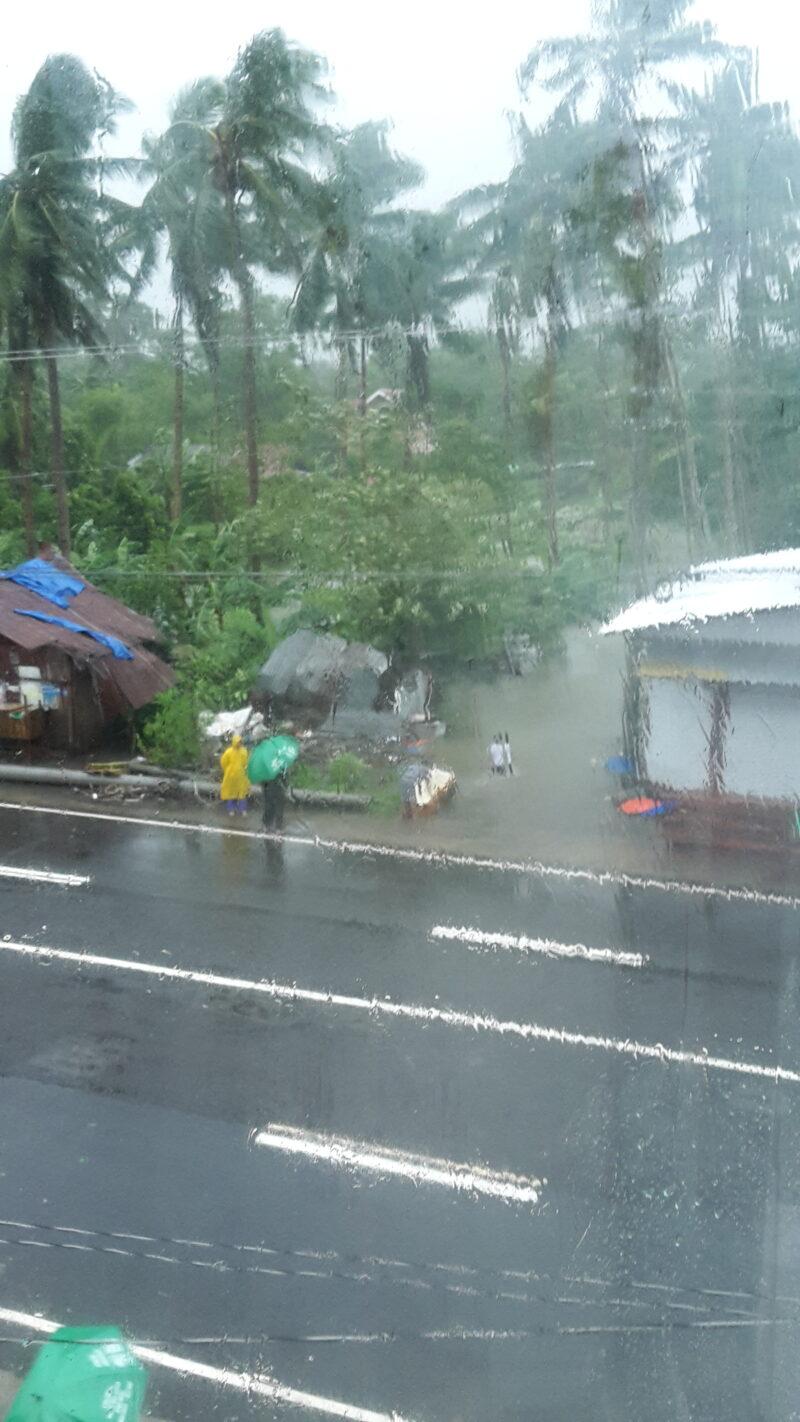
Highway in Baybay City – April 2022
Christopher Klapperich
“It is only a tropical depression, not a typhoon”, explained the woman behind the front desk as I was standing next to the glass door looking at the street and the never-ending rain. On this second day of my fieldwork, the alert level for Agaton, as the tropical depression was named in the Philippines, was still ranked low. People on the street started building up wooden barriers in front of houses and stores to block the water which the highway relentlessly navigated to their doorsteps. The busyness on the street was a huge contrast to the calmness of the women behind the front desk. Typhoon Odette (international name: Rai), which hit the Philippines four months earlier, in December 2021, “had much stronger winds and broke one of the windows in the second storey of the house,” she explained. Due to its high location, the accommodation was protected from the water. It seemed like there was nothing to worry about. Until this day, I had never experienced a tropical storm in the Philippines and thus did not have any comparison. While the ongoing extreme and homogenous noise of the rainfall lasted over the next hours and continuously strained my nerves, the staff of the accommodation reassured me that everything was fine and that this was no heavy storm. All I could do was trust the woman behind the front desk. Every year, eight to nine tropical cyclones hit the Philippine landmass (PAGASA 2023); most of them develop over the Philippine sea, making landfall on one of the eastern islands of the archipelago (Yumul et al. 2011). The island of Leyte where most of my fieldwork takes place is one of these eastern islands. Most of the people in the Philippines are used to these kinds of weather events, and to living in a country that seems to be permanently under reconstruction. The continuity of these extreme weather events in the Philippines leads to what Greg Bankoff (2004) has termed a “normalisation of threat” within society. A normalisation that confused me.
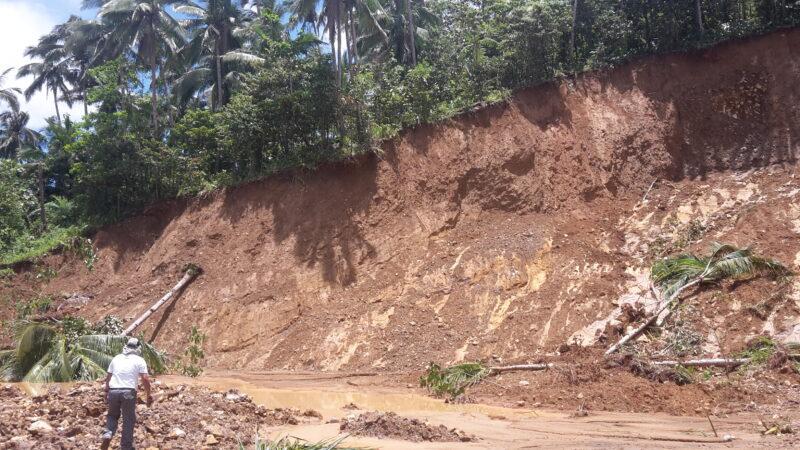
Landslide in Mailhi, Leyte – April 2022
Christopher Klapperich
A couple of days later, it became clear that the tropical depression was no “normal” extreme weather event: while one-third of the annual rainfall came pouring down onto the region of Leyte in only two nights, mountain slopes next to at least twelve communities slid down, burying about 300 people (NDRRMC 2022). Photos went viral showing huge muddy landscapes, toppled coconut trees, and isolated protruding roofs: the only leftover signs of former communities. Agaton is now known as one of the deadliest extreme weather events in Leyte in the last 30 years.
Having visited the Philippines to learn more about reforestation and native tree species, my fieldwork had paused before it started and, suddenly, it felt strange to even think about it. While I was constantly checking Facebook to read about the landslides during the day, I realized that, in the evenings, I felt uncomfortable sharing what had happened to the neighbouring communities with my friends and family at home. I was afraid to talk about it, afraid to acknowledge that being in the field is accompanied by a certain risk. A risk that had tragically left its mark on Leyte’s landscape and its people.
I conducted my first fieldwork in the Philippines in 2019. For my master’s thesis I followed environmental activists through Palawan’s old-growth forests to identify illegal logging spots. Considering the direct-action approach of the environmental activists that I accompanied and that the Philippines are one of the most dangerous countries for environmentalists (Global Witness 2020), facing risks in my fieldwork was not new to me. Still, the risk that I felt exposed to was different. In contrast to the illegal loggers which the environmentalists and I had faced, this “new” risk I experienced in the first days of my PhD fieldwork seemed to be beyond human agency – and that somehow made a difference.
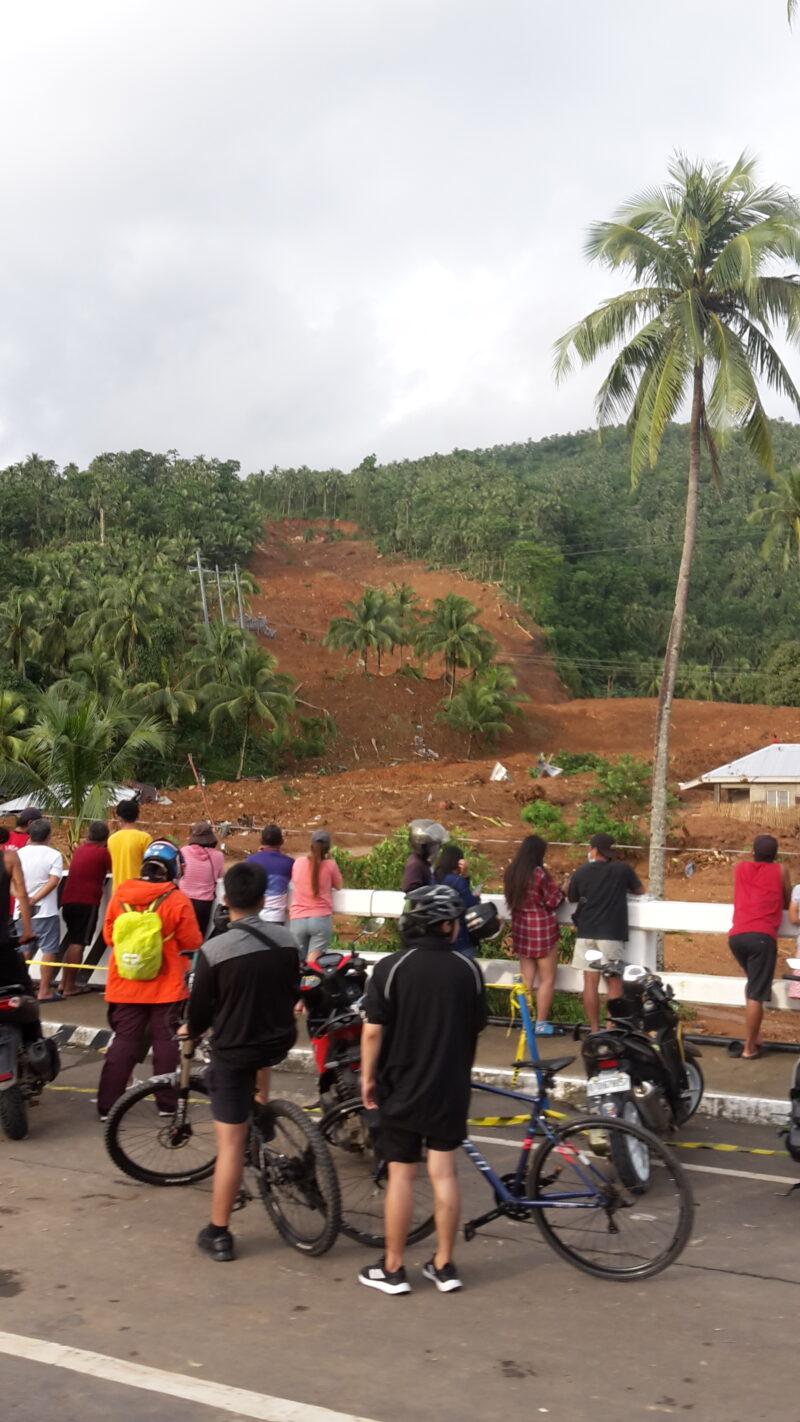
Landslide in Barangay Bunga, Leyte – April 2022
Christopher Klapperich
Being exposed to extreme weather events is perhaps the most common, shared experience within the Philippines. Doing fieldwork in such an environment therefore also means participating in disasters, and sharing the risk. Participant observation as the anthropological method is a practice of immersion. While the discipline’s tradition is clearly linked to people, I realized that to immerse myself in the field does not only mean immersing myself in a specific society but also in a specific environment – with all its potential consequences. While my studies and previous field trips prepared me for the social immersion, Agaton confronted me with an aspect of the Philippine environment that I might have avoided thinking about. Of course, I was aware that the Philippines are listed among the most disaster-prone countries (Atwii et al. 2022); pictures of typhoons like Yolanda (international name: Haiyan), and Odette were present in German news and social media. However, to get a complex and emotionally challenging insight into something that is framed, measured and indexed in abstract vocabulary as “risk” or “vulnerability” was not part of my plan.
As the rain stopped and the sun quickly dried the muddy areas in the following days, it almost seemed as if nothing had happened. While many people were still busy reconstructing and repairing their homes – physically as well as emotionally – public life started again, and with it my fieldwork. Throughout the next weeks, I accompanied scientists from the Tropical Ecology Institute of Visayas State University (VSU) in their daily work, specifically related to reforestation with native trees. In many conversations, the landslides were brought up to discuss the current forest cover. Also on Facebook, the extreme weather event and its consequences were highly present and posts about the potential influence of vegetation cover on the landslides were shared and commented on controversially (Fernandez 2022, Asio 2022). Disasters are far from being only natural phenomena; they are events that blur the line between environment and society (Oliver-Smith 2020, 37), and in the weeks after Agaton, people tried to make sense of what had happened and asked who is to blame for the tragic outcomes. Working on reforestation and native trees, my project suddenly overlapped with many vibrant discussions. It became clear to me that “disasters” are a focal point where several actors start to interact with each other and openly negotiate questions of responsibility and the role of forest cover in mitigating harm caused by tropical cyclones. These debates initiated by the tropical depression Agaton made it clear that “disasters” must be given a certain place within my project that I had not expected before and could not ignore any longer.
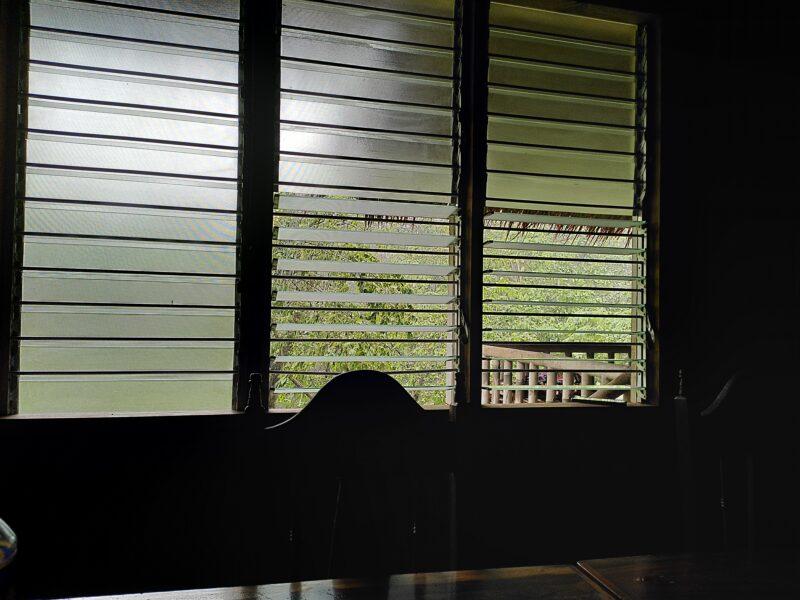
Negros – November 2022
Christopher Klapperich
Seven months later, during my second fieldtrip in the Philippines, I sat together with Paolo, Tata, and Irvin, three staff members of the Tropical Ecology Institute of Visayas State University, playing cards by candlelight. Since the electricity went out in the morning and did not come back during the day, candles and flashlights enabled us to cook, eat, and – finally – play. The three staff members and I had traveled to Negros, an island in the center of the Philippines, to make drone shots of reforestation sites and to talk to people involved in tree planting. The rest of the institute was going to follow within the next few days. But all plans came to a hold as the tropical cyclone “Paeng” made its way across the archipelago. Heavy rains and winds accompanied us all day, leaving no chance to fly a drone. But what worried the team most was the situation back home in Leyte where Paeng had entered the Philippine landmass that morning. Throughout the day we sat in our apartment, staring at our phones and waiting for news, videos and weather updates. One thing I learned in the weeks after Agaton is the relevance of the national meteorology institute PAGASA (Atmospheric, Geophysical and Astronomical Services Administration), which posts weather and storm updates on Facebook almost every hour. While our accommodation was in a very safe place on top of a small hill and in great distance to rivers and the coast, constantly sharing and watching videos of flooding made us nervous but also kept us busy – what else could we have done?
During the evening of the previous day, Visayas State University’s (VSU) president had informed the students to leave specific dormitories and move to evacuation centers because the sheer amount of rain from the tropical cyclone raised the water level of nearby rivers. While students were packing their belongings, Paolo got the news that his house was already knee-deep in water. Paolo, his wife, and her relatives, are living in a community close to VSU and next to a river that, like many others, raised incredibly fast. While his wife, Kleer, was trying to save as many belongings as possible from the flooding, Paolo called his colleagues at VSU to ask for a space within the university that was not affected and where his family could stay safe during the night. An hour later, the internet on Leyte’s west coast broke down and with that, also the connection to Paolo’s family. Being in Negros, almost a day trip away, he was visibly nervous and constantly in thoughts. Due to Paeng and the rough sea, all the waterways between the islands of Negros and Leyte were closed. Without any chance to reach his family, there was nothing left but to wait – and listen to the sound of the rain that was brought by the tropical cyclone that was simultaneously entering his house. There were a lot of heavy things in his house that his wife could not remove alone, like his motorcycle and their furniture, explained Paolo while we were sitting on our beds. When Paeng would pass, he would have to spend money to repair his house, to buy things that might not work anymore or might have soaked with mud. Money that he had saved for the future. But all of this, he highlighted, was not important; what would really count was that his wife and family were safe.
After a while, we stopped talking. Without any new information, everything we said seemed to be rather speculative and trying to sleep appeared to us as most reasonable. Throughout the next day until we ended up playing cards in the dark, I could not stop thinking about the number of extreme weather events and disasters that are hitting the Philippines every year: What does it mean to be in this continuous mode of material and emotional repair? These and many other related questions occupied my mind and are still accompanying me today. Listening to Paolo’s worries, it became clear to me that we do not share the same degree of risk and that we are also not equally exposed to these events. While I spend only a few months in the Philippines during fieldwork, Paolo, as well as the other people I met on my travels, are rooted in the archipelago. The place they call home is often described as a paradise, and not without reason. But there are times when the white beaches are filled with debris and toppled-down coconut trees blaze the trail of destruction. Being haunted by up to twenty tropical cyclones a year is part of this paradise, part of their home: to never be certain what the next cyclone will bring.
As the night of playing cards passed, the rain stopped and we got news from Leyte that everyone was safe and the water level of the rivers was lowering again. While the sea calmed down after Paeng moved out of the Philippine archipelago, the waterways opened again and enabled the rest of the institute’s team to meet us only four days later in Negros to continue the planned field trip. As quickly as plans change in the Philippines due to extreme weather, normality seems to return just as quickly. Even though I still find it hard to put into words how and to which degree the different tropical cyclones shaped my project, they certainly left a mark on me. In this regard, doing ethnographic fieldwork is most of the time not a method that offers direct answers to your research question, but, in my opinion, that is exactly where the strength of the method lies. Accompanying people in their daily life, being exposed to their environment, and sharing their worries, opens up the context in which all possible research answers are eventually embedded. Especially, during extreme events that disrupt everyday life, ethnographic fieldwork shows its main characteristic: an inherently intimate and social practice – one that offers you more insights than you have asked for and sometimes even more than you can grasp.
Literature:

